|
30th June 2014, Great Orme
The Dark Red Helleborines are flowering this year about two weeks earlier than 2013, so much like the general trend for 2014. However there seems to be fewer in flower on the roadside this year, with some flower spikes looking as if they have shriveled up due to lack of water. Perhaps we are a bit more experienced now, but we did spot more plants in flower up on the rock face, and these plants seemed to be in better condition than the roadside ones despite being rooted seemingly in small cracks in the limestone. Last year one plant by the roadside exhibited hypo-colouration. I think we saw it again, however this year it seems to show a bit more reddish colouration suggesting this may be an environmental, rather than genetic, effect.
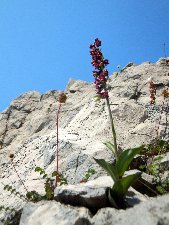 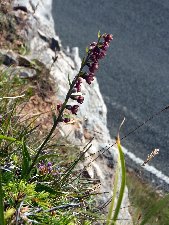 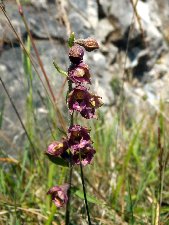
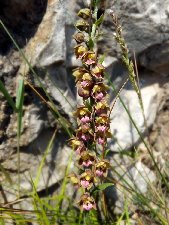 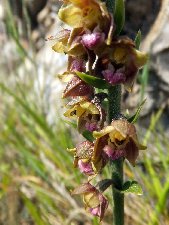
Roadside colonies of Common Spotted Orchids are quite common, when you look out for them. On the A55 North Wales Expressway there are several colonies. At the Flint junction on the west bound side, near Holywell golf course eastbound, at the top of Rhuallt hill both westbound side and central reservation, and between Pensarn and Old Colwyn near the quarry pier, again westbound side and many in the reservation. From the purple colouration, there may be some Northern Marsh Orchids too.
23rd June 2014, Vicarage Meadows
Having been fortunate in finding the Lesser Twayblade we pushed on to Vicarage Meadows to look for the Small White Orchid in one of its few remaining Welsh sites. This little reserve is literally in the middle of nowhere, about 8 miles from the nearest hamlet via a single track lane. Would out luck hold? Sadly no! Despite scouring the field separately, over and over, for 90 minutes, we failed to find any sign of a SWO. There were two squares marked by corner posts that may have marked where the SWOs grew, but repeated searches there showed nothing. Despite this, the outing was not a total failure. The meadow was alive with Heath Spotted Orchids, Marsh Fragrant Orchids, and some Greater Butterfly Orchids.
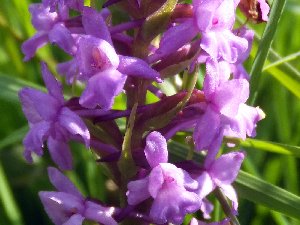 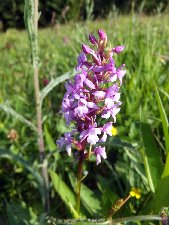 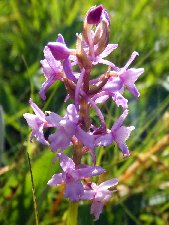
The Heath Fragrant Orchids
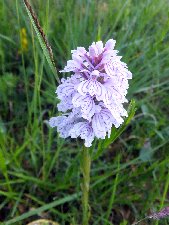 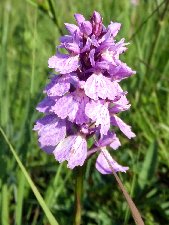 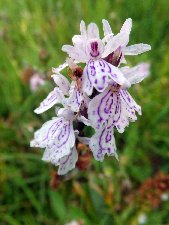 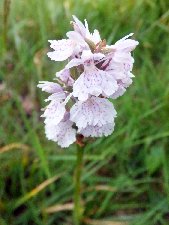
Some of the range of colour and pattern variation in the Heath Spotted Orchids
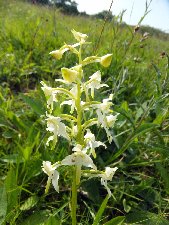 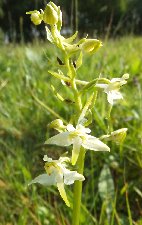 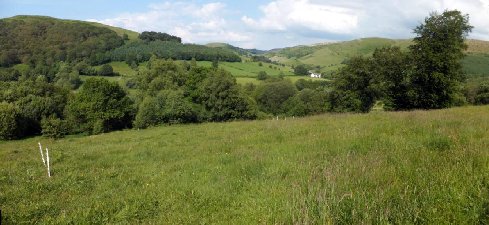
The Greater Butterfly Orchids starting to open, and the view from the meadow.
On the way home we stopped at the Common Spotted Orchids on the roadside just north of Dolfur near Newtown, Powys, on the A483. These seem to be even better this year, and on a positive note, while the verges had been mowed these had been avoided.
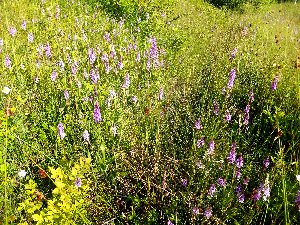 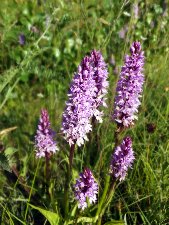 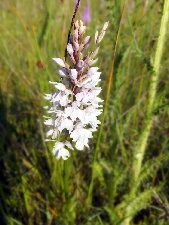
23rd June 2014, Hirnant Valley
Despite failed attempts to locate the Lesser Twayblade here, we tried again armed with further search locations and the knowledge that these orchids had been seen there the day before in reasonable numbers. Rather than retrying the moorland below the lay-by at the highest point of the road between Bala and Lake Vyrnwy we went down a bit towards the boundary stone and hunted where the heather is growing with sphagnum and tall sedges.
In the event it didn't take too long to find the first, but its diminutive size took us by surprise. I had expected to see the flower spike proud of the heather under which it grows, but they are way too small for that. However, the key to finding more was to look for the pair of ovate leaves. These do stand out better against the other vegetation that the flowers. Most of those we saw in flower already had their ovaries swelling with seed, but about half the total plants seen were missing the flower spike
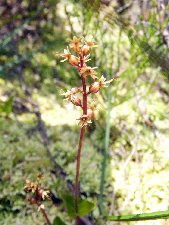 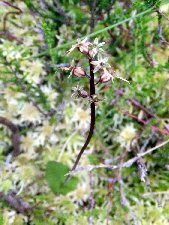 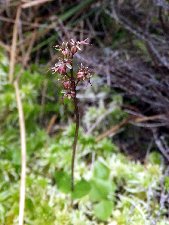 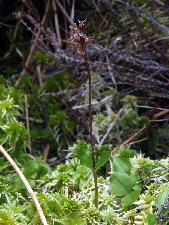
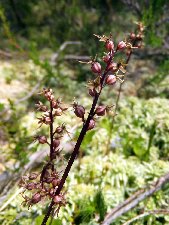 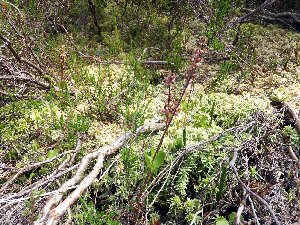 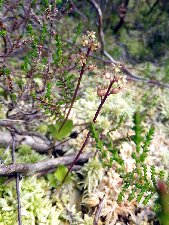
22nd June 2014, Local reports
A drop in at the Marford Broad-leaved Helleborine site showed that they are doing well, but will need at least two more weeks before they are worth seeing in full flower. This will be a full 3 weeks earlier than when they were seen in 2013.
On a sad note, the fine colony of Common Spotted Orchids growing but the side of the A483 between Gresford and Wrexham has been mowed into oblivion. The local council had tried to save money by neglecting the road verges, but caved in to local opposition and are now busy mowing everything at an inappropriate time of the year. I hope they return next year and don't suffer the same fate.
18th June 2014, Scabby Rock
I was passing near here three weeks after the last visit, and the orchids are flowering well now. The Greater Butterfly Orchids are in full flower, and I counted over 30 in the thicket to the left of the path. Those in tight bud at the last visit are revealed as Pyramidal Orchids. To me this seems an odd habitat, as they are normally seen in open situations such as sand dunes, not shady wooded areas. Those growing deep in the thicket are quite tall and straggly.
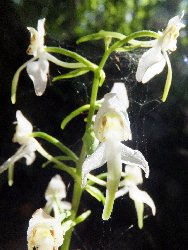 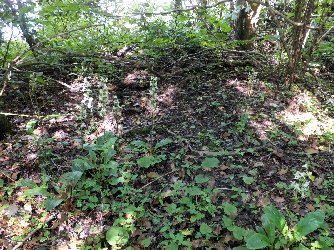 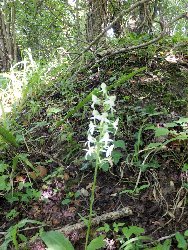
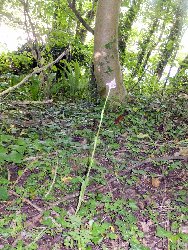 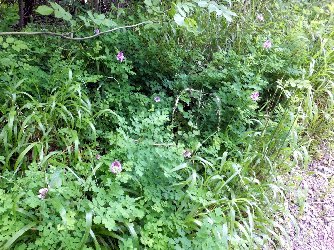
17th June 2014, Cap Griz Nez, France
Journeying back from Le Mans and after an overnight in Boulogne we had a bit of spare time before a ferry, and decided to call in at Cap Griz Nez. I did hope to find something there, but the land on the headland was fenced off, and much of it inhabited by sheep. However, looking down from the viewing platform below the lighthouse I could see a colony of at least 25 Bee Orchids. There was no (legal) way down to them, so I had to zoom in for a picture, but luckily found two more on the return to the car park which helped confirm their identity
Shortly after rejoining the A16 heading for Calais a roadside colony of (presumably) Common Spotted Orchids was noted at junction 37.
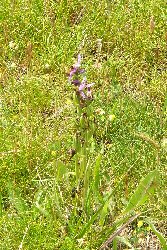 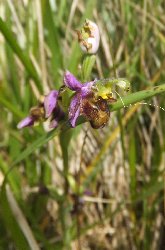
10th June 2014, Sandwich Bay
I went here last year a week later and the Lizard Orchids were mainly still in bud. This year, however, they were in full flower and just really impressive. Driving down to the coast road their presence was heralded by those growing in the front lawns of the houses there. I should have got a picture of these.
The only other orchid seen was some Pyramidals, though Southern Marsh Orchids were said to be doing well at that time.
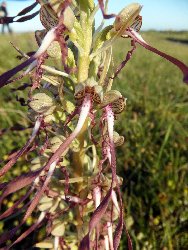 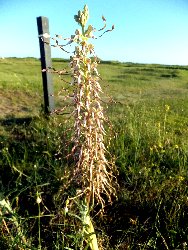 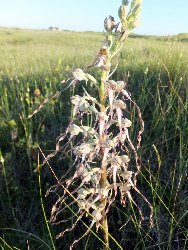
Typical examples, and a pale-flowered specimen. Below, a group in the grass on the sea side of the road.
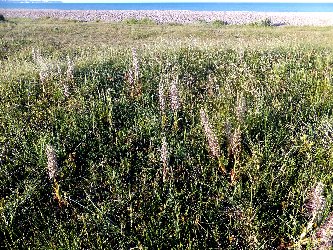
10th June 2014, Samphire Ho, Kent
I went here knowing I would be disappointed. The Early Spider Orchid flowers here in profusion, to the extent that the warden had referred to them as weeds. It was over a month or two since they were in flower but there was an outside chance one late one was still in flower. In the end we saw no evidence of them. Where I expected to see them was covered in thick summer vegetation, so little chance of seeing even a seed head. There were just a few Common Spotteds, in little groups.
The group of Common Spotteds on the roadside just out of Dover were doing well.
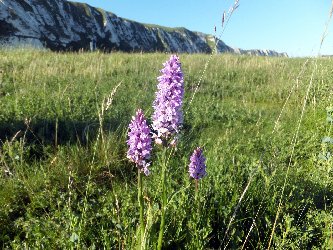 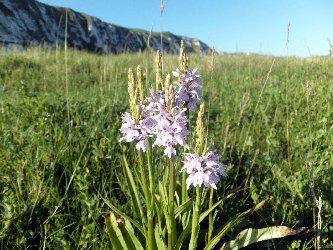
10th June 2014, near Stelling Minnis, Kent
Knowing I would be in Kent on this date I cast around for somewhere to see Lady Orchids. They do grow at a number of reserves, but a tip-off regarding a site on a little wooded lane would make finding them easier than hunting across a large site. Would we find them? Would they have gone over? The answers were `yes' and `nearly'. They were easier to find than expected, despite being under tree cover and their subdued colouring, due to their unexpected large size. There were two groups of plants, about 20 yards apart; one of 12 plants, and the other of 8. Some had gone over, and two flower spikes had been picked, but there were sufficient numbers still in flower for photography.
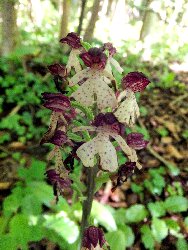 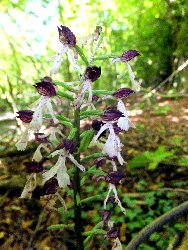 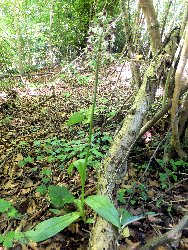
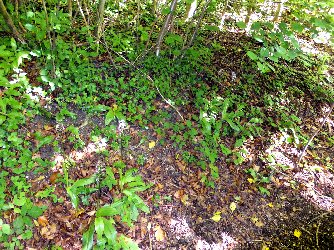 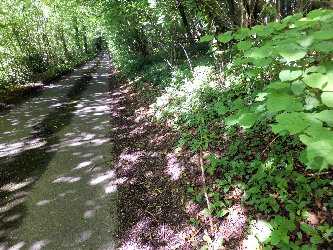
10th June 2014, Box Hill, Surrey
A stop-off here was in order to try and spot the Musk Orchids that grow above the Zig-zag Road, but we were unsuccessful, despite some very specific directions. By a week later than this only one had been seen at Park Gate Down, so is this a poor year for this species, or were we just a bit too early?
Nevertheless there were Common Spotteds by the gross, Common Twayblades (the smaller ones causing a couple of Musk Orchid false alarms) and a nice colony of Chalk Fragrant Orchids.
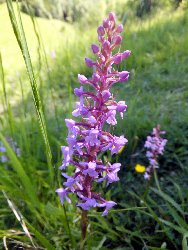 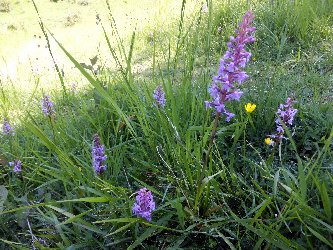
10th June 2014, Homestead Woods, Bucks
This is a (well) managed site, with a plethora of orchid species, but sadly with only a small lay-by to park on along very narrow lane. Obviously the aim of the visit was to see the Military Orchids here, one of the few places where these grow in Britain. We were not disappointed. There are several hundred, some fully grown, some smaller. Perhaps the only minus point was that most had wire cages around them; essential for protection from trampling especially before flowering, but the wire did intrude on many of the photos. The meadow has a number of criss-crossing tracks where it is safe to walk, and see all the orchids growing.
We started in the meadow field bordering the road, and other species seen there included Common Twayblades, Common Spotted Orchids, some nice deep pink Pyramidal Orchids, and a solitary Greater Butterfly Orchid in the top corner. Speaking to a couple of other visitors who were just leaving we got information about some Bee Orchids and a Fly Orchid. But before we reached that area I noticed a solitary White Helleborine, which had finished flowering, and what is most likely a Green Flowered Helleborine, yet to flower. Without seeing it in flower the sub-species of vectensis can only be tentative, but this is most likely geographically. The Bee Orchids were scanty, and we couldn't find the Fly Orchid. We were told it grew under a big tree, but had been directed to the edge of a wood with too much choice of big trees.
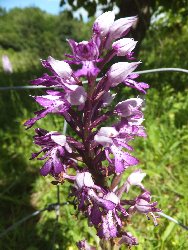 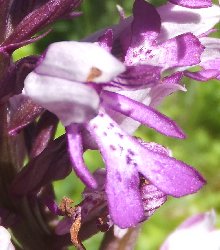 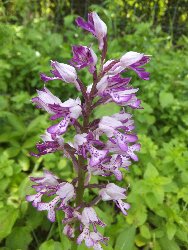
The Military Orchids
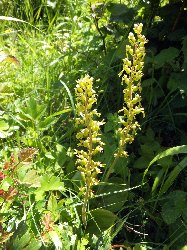 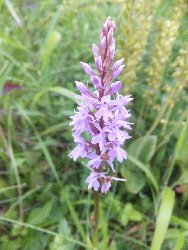 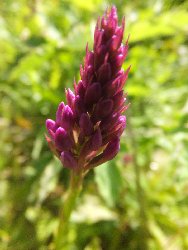 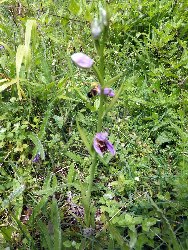
A pair of large Common Twayblades, a pink flowered Common Spotted Orchid, a richly coloured Pyramidal Orchid plus Bee Orchid
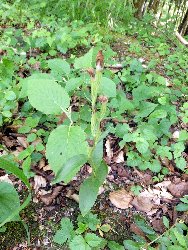 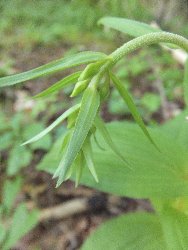 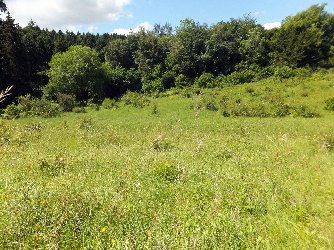
The `gone over' White Helleborine, and the yet-to-flower Green-flowered Helleborine; and a view of the meadow.
8th June and 21st June 2014, Alyn Waters Country Park
Quick visits to two local Bee Orchid sites in one morning on the 8th. At Alyn Waters we counted 80+ in three small areas; one near the Llay side car park, and the others either side of the path nearer the woods. They mostly seemed quite fresh with one or two pollinia still present.
The Common Twayblades, were both flowering and very plentiful, while the Common Spotted Orchids were just coming into flower. The Helleborines had the flower spikes unfurling, but we did spot a clump some way from their usual woodland habitat, in a spot where we hadn't seen them before. A return visit is in order to see whether these are Dune or Broad-leaved.
We didn't stay quite as long as would have liked, as a fun run around the park was due to start, and we didn't fancy being caught up in all that. I hope the stewards made sure no-one took short cuts through the orchid areas, trampling everything.
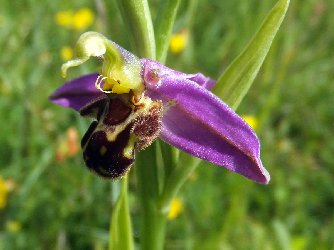 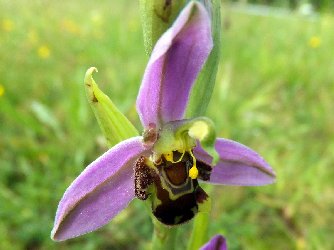 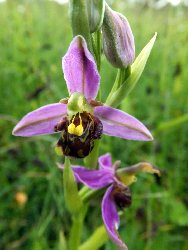
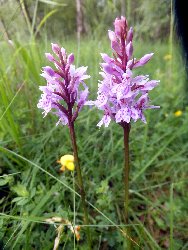 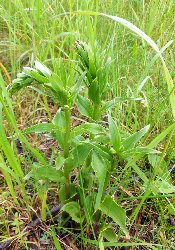 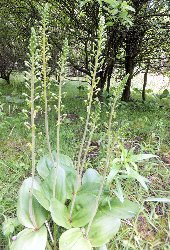
The follow-up visit on the 21st was to check on a few specific points. Firstly, were the Bee Orchids still going? Yes, they were, but showing their age a bit. A number of the lower flowers were finished and the ovaries showing signs of setting seed. A good number of them were seen in areas where we hadn't counted them on the 8th, so the numbers in just one bit of the park was 100+. The `stray' Helleborines are still a mystery; mainly because they are not yet in flower. They are beginning, unsurprisingly, to seem to be Dune Helleborines, with their untwisted ovary stems. They do lack the violet colouration at the base however. Still no sign of the CSO var Rhodochila. We studied a large area, where it was said to have flowered in 2013, and where hundreds of Common Spotteds are in flower, to no avail; am I looking in the right place, or has it gone. One Common Spotted Orchid did stand out. Growing on the path edge in woodland it stood a full 70cm tall, and the bracts were long; much longer than the flowers.
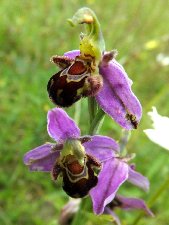 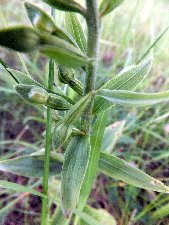 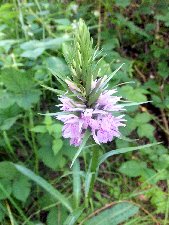
An aging Bee Orchid, details of the Helleborine ovary, and the big-bracted Common Spotted
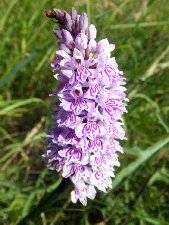 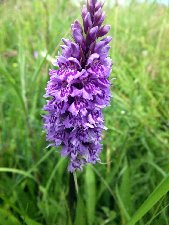
Colour variations of the typical Common Spotted Orchids
8th June 2014, near Ellesmere Port
Our third visit to this small and unlikely site. Sadly, it seems to have been a bit neglected of late, with signs, notice board, and benches vandalised or removed. The Bee Orchids here have never been numerous, but today only three at the southern end of little reserve near the canal were found. None to be seen in the woodland glades where they have been see previously. One plant showed flowers in three stages of the lip unfurling, while another was a clear 14-15 inches tall.
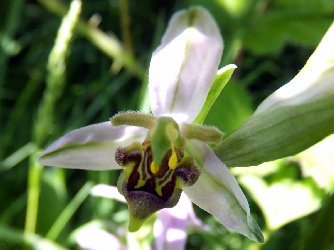 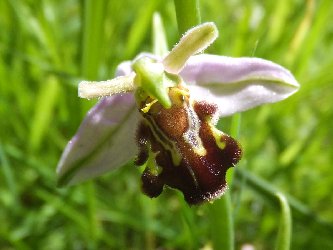 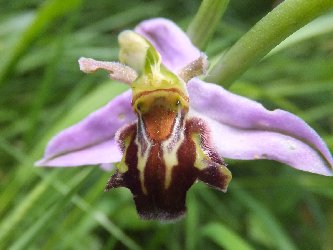 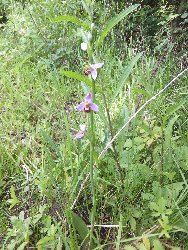
7th June 2014, Wrexham Industrial Estate
A return to a site first visited in 2013, and the Bee Orchids look even better this year. We counted 34 in total. The verge where they grow did not look as if it had been mowed this year, at least as close to flowering time. Hopefully it won't get a short back and sides before seed has been set. The empty land behind the Bee Orchid verge, which last year had Common Spotteds, Southern Marsh, and their hybrids is now closed off to the public, due of off-roading activity; a pity.
The early flowering of orchids this year is exampled by this site. In 2013 we saw the Bees in similar state of flowering three weeks later.
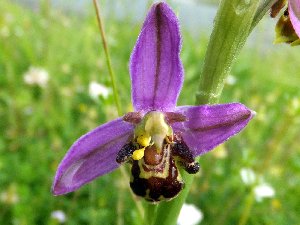 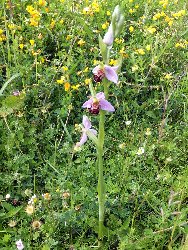
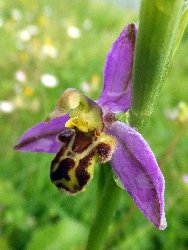 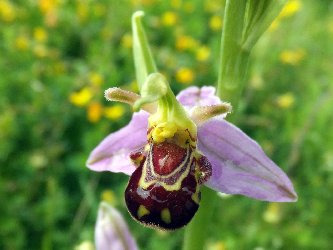
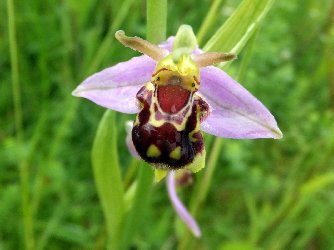
The Happy Bee Orchid
|
